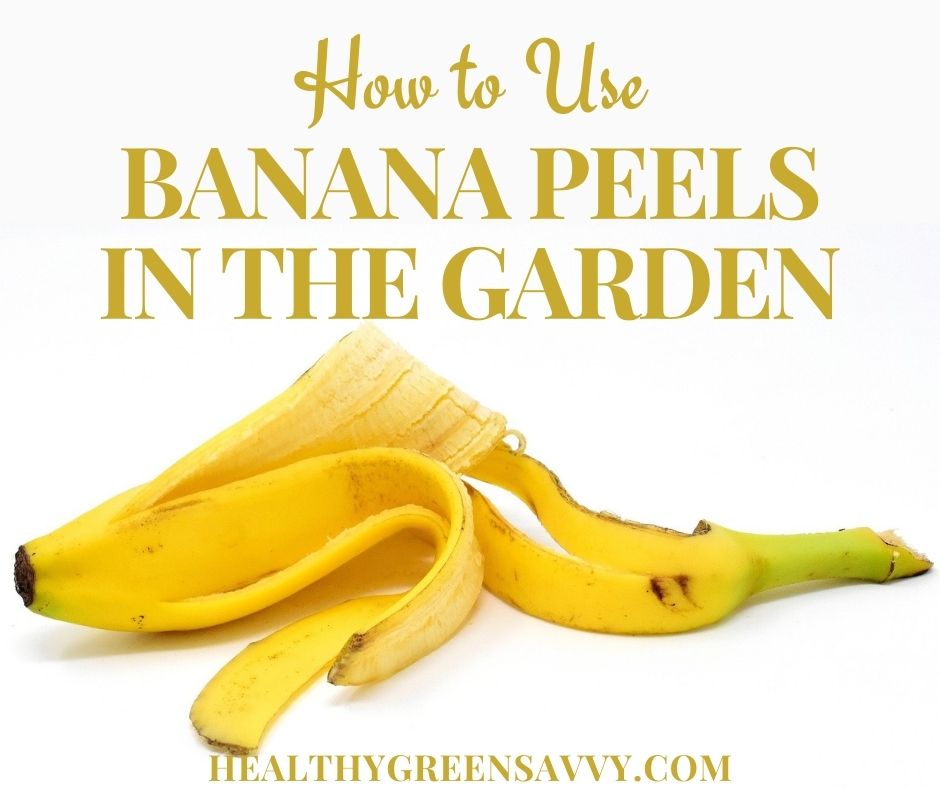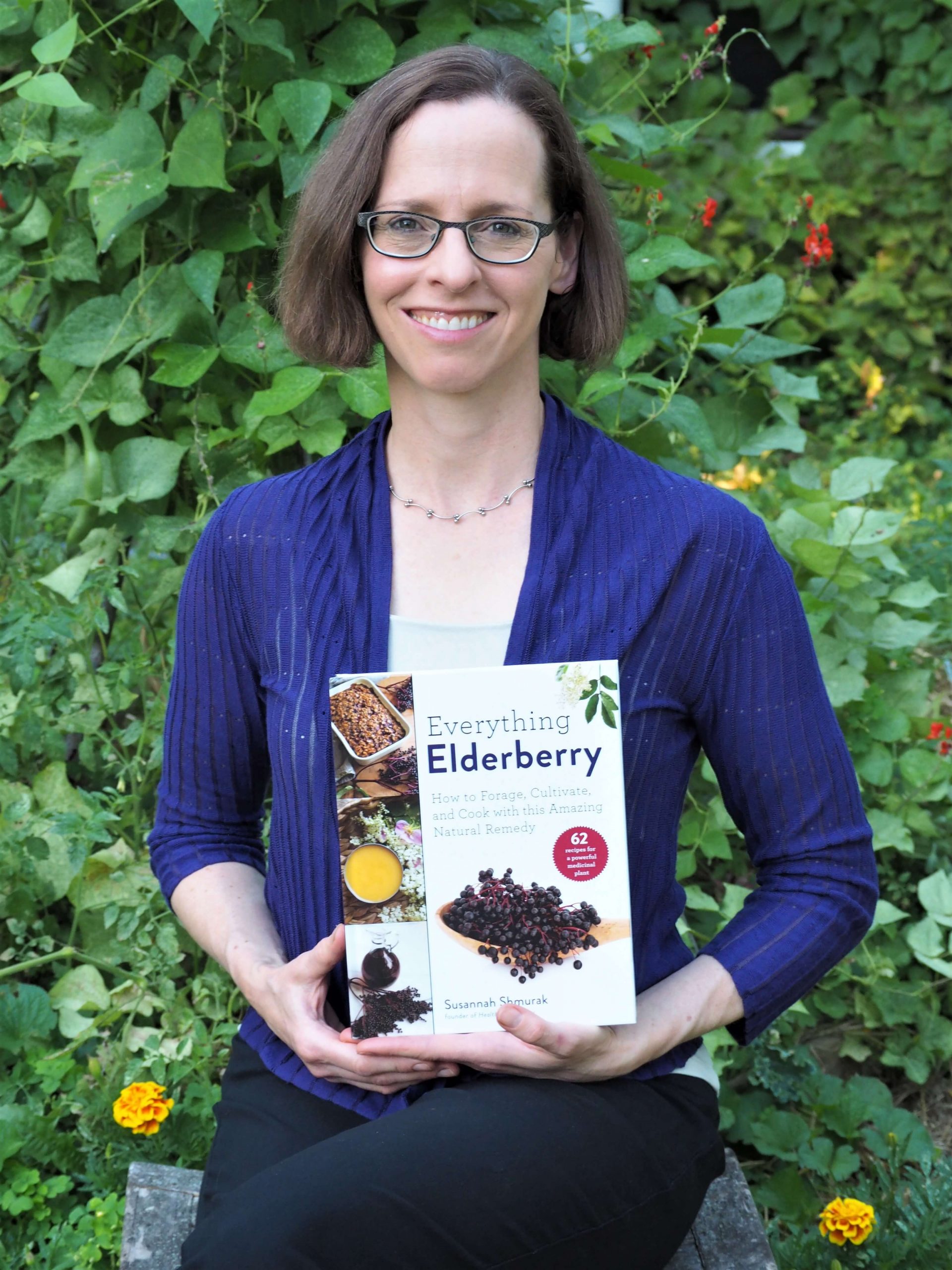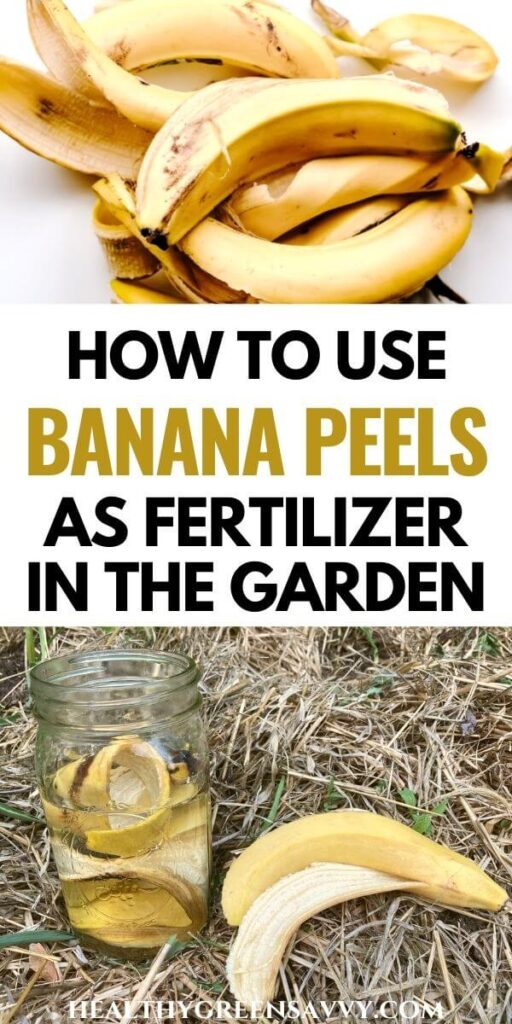Last Updated on July 11, 2023
Have you heard about banana peel fertilizer? There are rumors circulating on the internet that fertilizer made with banana peels can work magic on your plants. Are banana peels good for plants? Read on to find out best practices for using banana peels in the garden.

USING BANANA PEELS IN THE GARDEN: IS BANANA PEEL FERTILIZER GOOD FOR PLANTS?
We’re all about money-saving eco-friendly hacks here at HealthyGreenSavvy. Using food scraps like banana peels — something many folks toss in the trash (or better, compost) — to benefit your garden is one of many ways to save money on gardening while cutting the waste your household produces.
Lots of things most of us throw away have some terrific uses. Check out these 35 uses for orange peels, for example, or these 40 root to stem recipes using leaves, stalks, and seeds most people don’t realize are edible.
Or find out all the innovative uses for used coffee grounds, which, by the way, also need to be handled correctly in the garden. Here’s what to know about how to use coffee grounds in the garden.
You can also eat banana peels, actually, but that’s a subject for another post. Stay tuned — I’m hoping to publish that soon. Some people claim you can whiten your teeth with banana peels, while others use them as a home remedy for mosquito bites. We haven’t had much success with this last one, but let me know if you have!
We go through a lot of bananas around here. They’re a favorite snack for kiddos, and we love to use them in homemade banana ice creams and healthy smoothie recipes.
When we have the dehydrator running, we always make sure to add bananas to make our favorite chewy dried bananas, which are an incredibly delicious sweet treat made with nothing but bananas.
That leaves us with a whole lot of banana peels! Occasionally we dry some for making banana tea for sleep, but we still have plenty more. There’s only so much banana peel tea one can drink, ya know?
We’re working on other ways to use banana peels, but most head right to the compost bin, where they break down with all the other kitchen scraps and eventually help feed our garden. But are there other ways to use banana peels as fertilizer as well? And most importantly, are those ways better than simply composting banana peels?
DOES BANANA PEEL FERTILIZER FOR PLANTS WORK?
You may have heard about bananas as a source of potassium, and that banana peels contain even more than the sweet fruit inside.
Besides the fact there are loads more concentrated sources of potassium, much of the hubbub about banana peel fertilizer has little basis in the way plants actually access nutrients.
Potassium is a key nutrient our garden plants need. Its symbol, ‘K’ is what you see on fertilizers of all sorts, to show the ratio of potassium to nitrogen (N) and phosphorous (P).
While banana peels do contain some potassium, they also have phosphorus, and magnesium, iron, calcium, and copper, all of which — in theory at least — could benefit plants in your garden.
Here’s the problem: Any plant material we add to the garden needs to break down in order to make nutrients available to plants. In fact, while banana peels are breaking down in your garden soil, they may actually interfere with your plants’ ability to access nutrients.
Banana peels as fertilizer for plants may take up to two years to break down completely, all the while they’re actually doing the opposite of what you want, which is feeding your plants. In the case of banana peels buried in a planting hole, you may also be creating a barrier keeping your plants’ roots from penetrating the surrounding soil.
What about banana peel water fertilizer that’s so popular on social media? While soaking some banana peels in water may release some of their water-soluble compounds, much will stay locked up in the peel. What you’ll wind up with is water with marginally more nutrients that you’ll add to the soil when you water your plants with it.
You can also go to the trouble of drying your banana peels and grinding them up to make a granular fertilizer, but busy gardeners generally have enough trouble keeping up with weeds and their garden harvest. I’m too busy dehydrating herbs and the abundant harvests from our fruit trees to consider using my time this way.
USING BANANA PEELS IN THE GARDEN SO THEY ACTUALLY FERTILIZE YOUR PLANTS
So now that you’ve gotten that bit of garden science mastered, let’s consider the most practical and effective ways to use banana peels as fertilizer for plants.
1. Add Banana Peels to Your Compost or Worm Farm
Banana peels will do the most good for your garden if they’re digested by your worms or the microbes in your compost for awhile along with all the other kitchen scraps and yard trimmings. This will produce a balanced homemade fertilizer your plants can actually use.
Plus there’s no added effort dehydrating or soaking or grinding. Just into the compost with those banana peels, along with all your other food scraps.
2. Use Banana Peels as a Pest Repellent
Burying chopped banana peels at the surface of the soil, while it may not be the most effective homemade fertilizer, may help deter aphids and other insects out to destroy your crops. Orange peels placed around the plant are also supposed to help repel insects, so that may be worth trying as well.
HOW TO MAKE BANANA PEEL FERTILIZER FOR PLANTS IF YOU WANT TO EXPERIMENT
If you’re still keen to make your own banana peel fertilizer with nothing but banana peels, you have some options for garden experiments. Leave a comment to share your experience using banana peels as fertilizer if you try one of these methods, OK?
Option 1: Bury Whole Banana Peels
I was taught to plant a whole banana peel beneath my tomato plants, but it turns out this might not be the best method for using banana peels in the garden. Buried in the soil this way, they’ll take a long time to break down, all the while siphoning away nutrients from my tomato plants and potentially creating a barrier or air pocket around their roots.
If you do choose to try this method, consider placing the peel off to the side of the hole instead of right below the plant.
Option 2: Side Dress with Chopped Banana Peels
To help the banana peels break down, chop them into small pieces before burying them just beneath the soil surface near the plant you want to nourish.
Option 3: Make Dried Banana Peel Fertilizer
This option seems like a lot of extra work (and possibly electricity), but if you want to try making dried banana peel fertilizer, you need to gather your banana peels and dehydrate them in the oven or in a dehydrator until they’re crispy.
Use a blender or food processor to grind the dried banana peels into a powder, which you can use as a granular fertilizer the way you would with purchased fertilizers, either as a side dressing or to mix with garden soil during planting.
Option 4: Make a Banana Peel Water Fertilizer
Banana peels can be steeped in water to make a foliar feed or liquid fertilizer. To make liquid banana peel fertilizer, place banana peels in a jar of water for a week before removing and composting banana peels. Dilute 1 part banana peel water fertilizer with 4 parts water.
You can use banana peel water fertilizer at the base of plants or you can use it as a foliar spray. Some proponents claim banana peel water fertilizer will help repel aphids.
Though rhubarb leaves are poisonous if we consume them, some people make a pest repellent spray and foliar feed with them as well.
Option 5: Fermented Banana Peel Fertilizer
Some folks allow the banana peel water to ferment for an additional month or more to make a banana peel vinegar they use on acid-loving plants like blueberries. If you try this, dilute in plenty of water to avoid burning your plants.
Option 6: Plant Banana Peel Pieces with Direct-Seeded Crops
Use small pieces of banana peel under seeds as you plant them. Some adherents to this method claim that the decaying banana peel gives food to the developing plant, though I’d be concerned the roots wouldn’t be able to break through the peel.
Option 7: Banana Peel Slurry
Running your soaked banana peels through the blender can help them break down faster. Keep the water from your banana peel fertilizer tea, but instead of tossing the peels in the compost, blend them into a slurry. The yellow mush you’ll wind up with can be used as a (rather messy) side dressing.
If you’re keen to get the most out of your banana peels, you can try adding them to your homemade fruitfly trap before composting them. Fruitflies find the scent of banana hard to resist.
As for me, I’m going to stick with the no-fuss method of sending our banana peels to the compost bin.
Looking for garden hacks with more promise? Check out these posts:
How about you? Have you tried banana peel fertilizer? Does it seem to work?
Pin to save this info on banana peel fertilizer for later!
Banana peel fertilizer photo credits: Alexas photos, Julia Kuzenkov, Susannah Shmurak

Susannah is a proud garden geek and energy nerd who loves healthy food and natural remedies. Her work has appeared in Mother Earth Living, Ensia, Northern Gardener, Sierra, and on numerous websites. Her first book, Everything Elderberry, released in September 2020 and has been a #1 new release in holistic medicine, naturopathy, herb gardening, and other categories. Find out more and grab your copy here.



 Hi, I'm Susannah, a garden geek, energy nerd, and fan of healthy food and natural remedies. Need some simple, practical solutions for living healthier and greener? You've come to the right place! More about me and my green projects
Hi, I'm Susannah, a garden geek, energy nerd, and fan of healthy food and natural remedies. Need some simple, practical solutions for living healthier and greener? You've come to the right place! More about me and my green projects
Leave a Reply